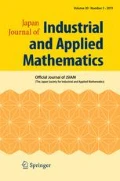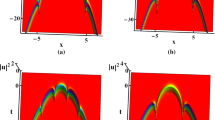Abstract
The mechanism of pulse switching is investigated analytically and numerically for a family of initial conditions with a solitonlike pulse in one channel and no signal on the other channel of the coupler. This investigation is performed directly in the coupled nonlinear Schroedinger equations that describe the directional coupler. This mechanism appears to be based on the simultaneous existence of the asymmetric and the symmetric soliton states: Switching then can take place for values of coupling constant and total energy for which the asymmetric soliton is stable and the symmetric soliton is unstable. The crucial features of the phase portrait in the infinite-dimensional space are described. In particular, near the switching threshold, a switching solution passes near the unstable symmetric soliton on its way to a new state with the energies in the channels reversed. On the basis of this mechanism a necessary condition for switching is found, which is confirmed numerically for some families of pulse shaped initial conditions. In the case of soliton switching with the energy as the switching parameter, this condition appears to give an accurate prediction of the actual switching threshold. The infinite-dimensional phase portrait has a simple structure, so that its features for a large part can be captured in a three-dimensional phase space.
Similar content being viewed by others
References
R.A. Adams, Sobolev Spaces. Academic Press, New York, 1975.
V.I. Arnold, Mathematical Methods of Classical Mechanics. Springer, Berlin, 1984, Ap- pendix 5.
N. Akhmediev and A. Ankiewicz, First-order exact solutions of the nonlinear Schroedinger equation in the normal-dispersion regime. Phys. Rev.,A47 (1993), 3213–3221.
N. Akhmediev and A. Ankiewicz, Solitons, Nonlinear pulses and beams. Chapman & Hall, London, 1997.
T.B. Benjamin, The stability of solitary waves. Proc. R. Soc. Lond.,A.328 (1972), 153–183.
M.S. Berger, Nonlinearity and Functional Analysis. Academic Press, New York, 1977.
G.J. Brinkman and T.P. Valkering, Soliton decay in a Toda chain caused by dissipation. J. Appl. Math. Phys. (ZAMP),41 (1990), 61–78.
P.L. Chu, G.D. Peng and B.A. Malomed, Analytical solution to soliton switching in nonlinear twin-core fibers. Opt. Lett.,18 (1993), 328–330.
P.T. De Boer, Soliton switching in directional couplers. Master Thesis, University of Twente, 1995.
G.L.A. Derks and E.W.C. Van Groesen, Dissipation in Hamiltonian systems: decaying c- noidal waves. SIAM J. Math. Anal.,27 (1996), 1424–1447.
S.M. Jensen, The nonlinear coherent coupler. IEEE J. Quant. Electr.,18 (1982), 1580–1583.
T. Kato, Perturbation Theory for Linear Operators. Springer, New York, 1966.
Y.S. Kivshar, Switching dynamics of solitons in fiber directional couplers. Opt. Lett.,18 (1993), 7–9.
B.A. Malomed, I.M. Skinner, P.L. Chu and G.D. Peng, Symmetric and asymmetric solitons in twin-core nonlinear optical fibers. Phys. Rev.,E53 (1996), 4084–4091.
J. Marsden and A. Weinstein, Reduction of symplectic manifolds with symmetries. Rep. Math. Phys.,5 (1970), 121–130.
J. Marsden, Lectures on Mechanics. Cambridge University Press, Cambridge, 1992.
P.M. Morse and H. Feshbach, Methods of Theoretical Physics. McGraw-Hill, New York, 1953.
C. Paré and M. Florjanczyk, Approximate model of soliton dynamics in all-optical couplers. Phys. Rev.,A41 (1990), 6287–6295.
M. Romagnoli, S. Trillo and S. Wabnitz, Soliton switching in nonlinear couplers. Opt. Quant. Electron.,24 (1992), 1237–1267.
G.I. Stegeman and E.M. Wright, All-optical waveguide switching. Opt. Quant. Electron.,22 (1990), 95–122.
J.M. Soto-Crespo and N. Akhmediev, Stability of soliton states in a nonlinear fiber coupler. Phys. Rev.,E48 (1993), 4710–4715.
E. Van Groesen and E.M. De Jager, Mathematical Structures in Continuous Dynamical Systems. North-Holland, Amsterdam, 1994.
E. Van Groesen, F.P.H. Van Beckum and T.P. Valkering, Decay of travelling waves in dissipative Poisson systems. J. Appl. Math. Phys. (ZAMP),41 (1990), 501–523.
J. Wilson and G.I. Stegeman, All-optical switching of solitons in an active nonlinear direc- tional coupler. Opt. Quant. Electron.,24 (1992), 1325–1336.
E.M. Wright, G.I. Stegeman and S. Wabnitz, Solitary-wave decay and symmetry-breaking instabilities in two-mode fibers. Phys. Rev.,A40 (1989), 4455–4466.
I.M. Usunov, R. Muschall, M. Gölles, Yuri S. Kivshar, B.A. Malomed and F. Lederer, Pulse switching in nonlinear fiber directional couplers. Phys. Rev.,E51 (1995), 2527–2537.
Author information
Authors and Affiliations
About this article
Cite this article
Valkering, T.P., De Boer, P.T. & Hoekstra, H.J.W.M. Soliton switching in directional couplers. Japan J. Indust. Appl. Math. 16, 65 (1999). https://doi.org/10.1007/BF03167525
Received:
Revised:
DOI: https://doi.org/10.1007/BF03167525




